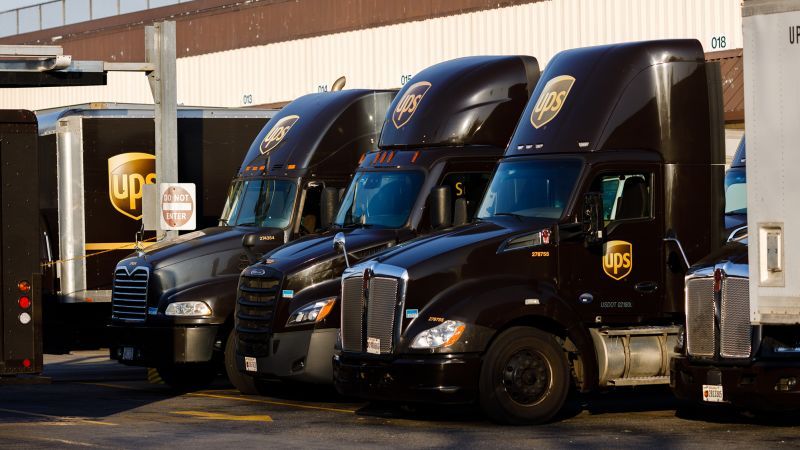What the potential UPS strike could mean for your packages
New York CNN —
A UPS strike by 185,000 workers 25 years ago brought the logistics giant’s operations to a standstill. The 15-day strike slashed package deliveries, overwhelmed the US Postal Service and FedEx, and hurt businesses across the United States.
Now, more than 340,000 UPS workers represented by the Teamsters union are threatening to strike over pay, hours and working conditions if there is no agreement in contract talks between the company and the union. If a strike takes place, it would be the largest single-employer strike in US history.
The work stoppage would also kick off as shoppers head into the back-to-school season and retailers prepare for the peak holiday stretch later in the year.
Striking employees of UPS in Chicago in 1997, the last major UPS work stoppage. Jeff Haynes/AFP/Getty Images/FILE
How bad could it get? Logistics experts predict that a short UPS strike would not be as devastating as it was in 1997 because things have changed in the intervening quarter-century: There are more shipping alternatives, for example. However, if the strike lasts longer than a week, there will be some empty shelves, higher prices, and slower package deliveries for customers, they say.
In a worst case scenario, a longer-term UPS strike could cause major disruptions to the US supply chain network.
More options now
Shippers have more options than they did in 1997: FedEx and regional carriers have grown since then, and Amazon’s logistics operation didn’t even exist then.
Walmart, Target and other retailers have also built their own last-mile delivery operations and offer customers the option to buy online and pick up their orders in stores. Gig companies such as Uber have since entered the market to deliver, too.
“The big lesson learned from that strike was to diversify,” said Cathy Roberson, the head of Logistics Trends & Insights, a supply chain research firm.
UPS and the Teamsters' union contract expires August 1. Richard Drew/AP
The economy has slowed and many consumers have pulled back on discretionary goods like electronics and clothing. That means demand isn’t as high as it was earlier in the pandemic, and retailers don’t need to bring in as much inventory for back-to-school shopping and the holidays. In fact, many companies are stuck with too much merchandise right now.
UPS’ revenue fell 6% in the first quarter compared to a year earlier and it said in April that it expects “volume to remain under pressure.”
“If you look at the overall market, nobody is seeing a pickup anymore,” Roberson said. “From an economic perspective, we’re going to have a very muted peak season.”
Businesses have also had time to prepare for the possibility of a strike.
FedEx and other carriers have encouraged shippers for months to switch away from UPS to avoid any delays from a strike.
Odds of a strike
UPS delivers about a quarter of all US packages to their final destination, according to Pitney Bowes, a global shipping and logistics firm, and there is not enough capacity in the market to replace UPS. And its share of shipments is even greater than that number indicates, since many of the packages being delivered by the US Postal Service are moved by UPS.
Overall, UPS handled 18.7 million domestic packages a day on average in the first three months of this year.
Small and medium-sized businesses lower in the pecking order than big-box chains would see the most delays from a lengthy strike, logistics experts say.
“Big retailers have contingency plans in place,” said John Haber, the chief strategy officer at third-party logistics provider Transportation Insight Holding Company, who worked for more than a decade in UPS’ corporate finance office.
Businesses and customers in rural areas would also be most affected by a longer strike.
“If you get outside of three days, then you start going into the danger zone” in remote areas, he said. “That’s when things really start to get bottlenecked. And then you get behind.”
Deal may be likely
Logistics experts generally believe a prolonged strike with damaging implications to businesses and the economy will be averted. Both sides have too much to lose in a lengthy dispute.
UPS CEO Carol Tome has been predicting a deal will be reached without a strike.
“We are aligned on several key issues,” she said in April. “While we expect to hear a great deal of noise during the negotiation, I remain confident that a win-win-win contract is very achievable, and that UPS and the Teamsters will reach agreement by the end of July.”
Teamsters General President Sean O’Brien, while acknowledging the progress that has been made, refuses to say whether he thinks a strike is likely or not.
“When you get into the meat and potatoes of wages and benefits, things can get very dicey, very controversial,” O’Brien told CNN last week. “Our goal is to get the best deal to avoid a strike.”
A promising indicator of an agreement came this week when negotiators for UPS and the Teamsters reached a tentative agreement on a crucial issue in the contract talks: the installation of air conditioning – gradually – in its entire fleet of 95,000 delivery vans.
“The odds of a strike are as high as they have been since 1997, but they’re still less than 50%,” said Alan Amling, a fellow at the University of Tennessee’s Supply Chain Institute and a former UPS executive.
“Both UPS and the Teamsters know that the volume that leaves them during a strike would be gone for good because there are alternatives. It’s mutual destruction if that happens,” he said.
Source: CNN


